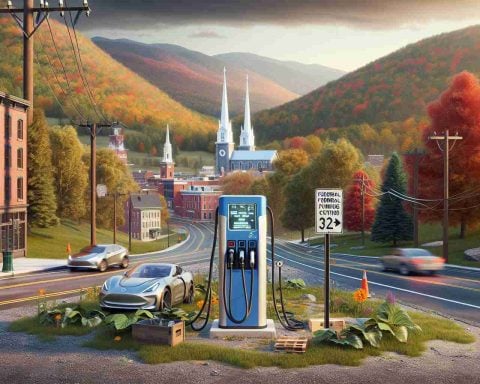- The Federal Highway Administration has paused a $5 billion initiative for high-speed EV chargers in the U.S.
- The suspension affects the National Electric Vehicle Infrastructure Formula Program (NEVI), under new leadership’s cautious review.
- South Carolina sought $70 million to enhance its EV charging infrastructure on major routes.
- The NEVI program could cover up to 80% of costs for DC fast chargers.
- A vision of charging stations every 50 miles is at risk due to the funding freeze.
- Drivers are eager for more charging options, contrasting with the established Tesla Supercharger network.
- There remains hope for a quick resolution to support the growing demand for electric mobility.
In a surprising twist, the Federal Highway Administration has put the brakes on a transformative $5 billion initiative to install high-speed electric vehicle (EV) chargers across the U.S., temporarily halting new funding. The review comes under fresh leadership at the Department of Transportation, applying a cautious approach to the National Electric Vehicle Infrastructure Formula Program, or NEVI.
States, including South Carolina, were poised to benefit significantly. With a planned allocation of $70 million, the state aimed to boost EV charging infrastructure along major routes, enabling drivers to recharge quickly and conveniently. The NEVI program aims to cover up to 80% of installation costs for state-of-the-art DC fast chargers, which can replenish a vehicle’s battery in a lightning-fast 20 minutes.
Imagine a seamless road trip where travelers could effortlessly access charging stations every 50 miles—a vision South Carolina has been striving toward. The plan includes installing charging stations in clusters, ready to power most EV brands in today’s market.
Yet, as drivers like Randy Owen express their desire for more charging options, the freeze raises concerns about the future of EV travel. With established networks like Tesla’s Superchargers leading the way, there’s an urgent need for expanded infrastructure to support the growing EV community.
As the review unfolds, the hope remains for swift action, ensuring that electric mobility remains not just a dream, but a convenient reality. Will the future of EV charging rev up again soon? Stay tuned for updates!
Is the Future of EV Charging in Jeopardy? Discover Critical Insights!
Current State of EV Charger Installations Post NEVI Review
The unexpected halt by the Federal Highway Administration (FHWA) on the National Electric Vehicle Infrastructure Formula Program (NEVI) leaves many states, including South Carolina, in suspense regarding their planned EV charging initiatives. This $5 billion project aimed to provide a robust framework for high-speed electric vehicle (EV) charging stations across the United States, promising widespread accessibility.
# Key Information:
1. Market Forecasts: The EV charging infrastructure market is projected to grow substantially, with estimates predicting annual growth of over 30% as more manufacturers push for electric vehicle production. Investments in charging networks are critical to support this growth.
2. Pros and Cons:
– Pros:
– Increased convenience for EV users.
– Reduction in range anxiety associated with EV travel.
– Job creation within the installation and maintenance sectors.
– Cons:
– Delays in charging infrastructure could hinder EV adoption.
– Reliance on public funding may introduce instability in development timelines.
3. Use Cases: Many use cases advocate for the installation of chargers at strategic locations—highways, urban areas, and near businesses—to cater to a diverse range of EV drivers, from commuters to long-distance travelers.
4. Limitations: The current review and freeze on funding pose significant challenges, delaying the development of necessary infrastructure to sustain the growing EV market.
5. Trends: Recent trends indicate a shift towards more integrated and user-friendly charging options, including mobile apps for locating charging stations, payment integration, and real-time availability.
6. Sustainability Aspects: The push for better charging infrastructure not only supports EV adoption but also aligns with global sustainability goals, reducing emissions and reliance on fossil fuels.
# Most Important Questions Addressed:
1. What impact will the NEVI program review have on EV charging infrastructure?
– The review’s freeze delays the rollout of essential charging stations, which may slow the adoption of electric vehicles as drivers face potential range anxiety.
2. What are states like South Carolina doing to prepare for EV growth despite uncertainties?
– South Carolina planned to allocate $70 million to enhance charging infrastructure, thereby increasing the installation of DC fast chargers, and is advocating for continued support from federal initiatives.
3. How does the private sector, like Tesla, influence the overall EV charging landscape amid government program delays?
– Private companies, notably Tesla, continue expanding their Supercharger networks, which sets a benchmark for EV charging efficiency and availability, creating pressure on public initiatives to catch up.
# Explore More:
For more insights and real-time updates on EV infrastructure developments, visit Department of Energy and Department of Transportation.














